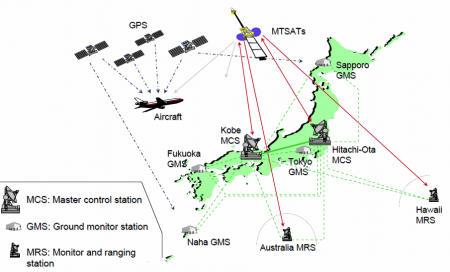If you wish to contribute or participate in the discussions about articles you are invited to contact the Editor
MSAS Ground Segment: Difference between revisions
No edit summary |
|||
| Line 8: | Line 8: | ||
}} | }} | ||
The Multi-functional Satellite Augmentation System (MSAS) is the Japanese [[SBAS General Introduction|SBAS]] System: a GPS Augmentation system with the goal of improving its accuracy, integrity, and availability, and that uses the Multifunctional Transport Satellites (MTSAT) owned and operated by the [http://www.mlit.go.jp Japanese Ministry of Land, Infrastructure and Transport] and the [http://www.jma.go.jp Japan Meteorological Agency (JMA)]. Tests | The Multi-functional Satellite Augmentation System (MSAS) is the Japanese [[SBAS General Introduction|SBAS]] System: a GPS Augmentation system with the goal of improving its accuracy, integrity, and availability, and that uses the Multifunctional Transport Satellites (MTSAT) owned and operated by the [http://www.mlit.go.jp Japanese Ministry of Land, Infrastructure and Transport] and the [http://www.jma.go.jp Japan Meteorological Agency (JMA)]. Tests during Initial Operational Phase were accomplished successfully, and MSAS for aviation use was declared operational on September 27, 2007.<ref>[http://en.wikipedia.org/wiki/Multi-functional_Satellite_Augmentation_System MSAS in Wikipedia]</ref> | ||
MSAS | ==MSAS Ground Segment== | ||
GPS signals are received at the MSAS Ground Monitor Stations and MSAS Monitor & Ranging Stations. These stations check operational status of GPS, and transmit GPS data to Master Control Stations that analyze GPS error and ionospheric delay. Then, these Master stations compute Augmentation information and broadcast it to GEO MTSAT (Multi-functional Transport Satellite)<ref>[http://en.wikipedia.org/wiki/Multi-Functional_Transport_Satellite MTSAT in Wikipedia]</ref> satellites. Those satellites, MTSAT, rebroadcast the correction messages back to Earth, where MSAS-enabled GPS receivers use the MSAS corrections to compute a reliable and accurate position. | |||
The MSAS Ground Segment is composed of four '''Ground Monitor Station (GMS)''' that collect information on the GPS and MTSAT signals. They are placed on Sapporo, Tokyo, Fukuoka and Naha. | The MSAS Ground Segment is composed of four '''Ground Monitor Station (GMS)''' that collect information on the GPS and MTSAT signals. They are placed on Sapporo, Tokyo, Fukuoka and Naha. | ||
Revision as of 07:55, 27 July 2011
| MSAS | |
|---|---|
| Title | MSAS Ground Segment |
| Author(s) | GMV. |
| Level | Basic |
| Year of Publication | 2011 |
The Multi-functional Satellite Augmentation System (MSAS) is the Japanese SBAS System: a GPS Augmentation system with the goal of improving its accuracy, integrity, and availability, and that uses the Multifunctional Transport Satellites (MTSAT) owned and operated by the Japanese Ministry of Land, Infrastructure and Transport and the Japan Meteorological Agency (JMA). Tests during Initial Operational Phase were accomplished successfully, and MSAS for aviation use was declared operational on September 27, 2007.[1]
MSAS Ground Segment
GPS signals are received at the MSAS Ground Monitor Stations and MSAS Monitor & Ranging Stations. These stations check operational status of GPS, and transmit GPS data to Master Control Stations that analyze GPS error and ionospheric delay. Then, these Master stations compute Augmentation information and broadcast it to GEO MTSAT (Multi-functional Transport Satellite)[2] satellites. Those satellites, MTSAT, rebroadcast the correction messages back to Earth, where MSAS-enabled GPS receivers use the MSAS corrections to compute a reliable and accurate position.
The MSAS Ground Segment is composed of four Ground Monitor Station (GMS) that collect information on the GPS and MTSAT signals. They are placed on Sapporo, Tokyo, Fukuoka and Naha.
The GMS stations send their data to two Master Control Station (MCS) in Kobe and Hitachiota, that compute precise differential corrections and integrity bounds and send them to the MTSAT satellites for rebroadcast to the User Segment.
The MSAS Ground Segment is completed with two Monitor and Ranging Station (MRS) in Hawaii (USA) and Camberra (Australia), whose purpose is primarily the correct orbit determination of the MTSAT satellites, and they also work as GMS stations. [3]
The prime contractor for the MSAS program is NEC Corporation. NEC manufactured and delivered MSAS under contract with the Civil Aviation Bureau, Ministry of Land, Infrastructure, Transport and Tourism of Japan.

